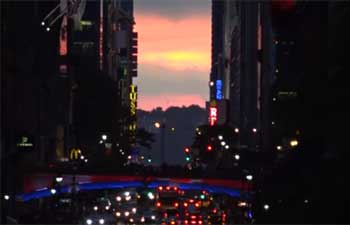By Peter Mertz
SALT LAKE CITY, June 3 (Xinhua) -- Sparsely populated America's West is the darkest place in the continental United States - perfect for seeing tiny flashes of light miles above the Earth.
Those tiny flashes - occurring in a millisecond just as a lightning bolt explodes - are releasing gamma rays and creating antimatter, and one facility in Utah is leading the world in measuring and detecting these bursts.
"The significance of this research is profound," said Maryland scientist Benjamin Taub.
"It draws science one step closer to understanding one of the last mysteries on Earth - the source of lightening," Taub told Xinhua.
AMAZING SCIENTIFIC DISCOVERY
Last month, scientists at the University of Utah announced that between 2014 and 2016, their massive particle collection array had detected 10 downward terrestrial gamma ray flashes, or TGFs.
Electromagnetic radiation runs the gamut from low energy radio waves, microwaves, and infrared - to visible high-energy bursts and ultraviolet, x-rays, and gamma rays, including TGF's - the most powerful explosions in the universe.
The news was the first to link downward TGFs with the initial "leader stage" of lightening.
It also confirmed that gamma bursts can originate from the Earth, and are not just caused by violent celestial events such as exploding stars, the prevailing thought when a satellite recorded the first TGF flash in 1994.
Previously, only six downward gamma ray flashes had ever been recorded on Earth.
"To be able to measure, contain, or even capture a gamma ray - that's an amazing scientific discovery with limitless applications, including energy," Taub said.
Scientists have also determined that gamma rays - emitted a nanosecond after lightning is sparked when air masses collide - can also shoot upwards, beaming the rays into space.
Since discovering the upward flashes, physicists have wondered whether cloud-to-ground lightning produced similar gamma ray bursts that beam downward.
Two facilities on Earth, one in Utah, are confirming that this is happening, and are stunning the scientific community with gamma ray data they are collecting.
COSMIC RAY COLLECTION
John Belz, professor of physics at the University of Utah and leading the lightning project, said gamma ray flashes have been seen from satellites orbiting the Earth for 20 years.
But now they are being measured and defined like never before in history.
Belz has emerged as a national expert in this 21st century blockbuster science field, following American giants Paul Krehbiel, Bill Rison, and Ron Thomas at the New Mexico Institute of Mining and Technology.
In 1998 Belz was doing research in Montana, and first got connected to the Cosmic Ray Group. By 2005, he had moved to Utah for good to work with a top team of scientists he considers mentors.
The then 35-year-old Belz first got a 120,000 U.S. dollar National Science Foundation (NSF) grant in 2000, for the "Study of the Highest-Energy Cosmic Rays."
Since then, Belz credits Utah's Cosmic Ray Physics Group and renowned scientists Gordon Thomson, Charlie Jui, Pierre Sokolsky and John Matthews, for nailing down about 18 million U.S. dollars in NSF grants for some 16 projects related to the school's cosmic ray data collection efforts.
In an exclusive interview with Xinhua, Belz revealed that the elite Utah facility will soon add 500 more "scintillating collectors" with grant money coming from Japan, to increase and enhance collection capabilities.
That addition will double the facility's existing collectors, and scientists are thrilled by the potential data soon to be seen.
LIGHTENING
"There are some unknowns and uncertainties about how lightening is generated...these studies are contributing to the scientific breakdown of how lightening is started," said Belz, who earned a Masters and Ph.D. in physics at Temple University in Philadelphia, in the eastern U.S. state of Pennsylvania.
"In the case of lightening, we have a pretty good idea about what plays in the separation of electric charge in air - it has to do with ice crystals going up though thermal drafts, and positive and negative currents that collide," he explained.
"One of the underlying issues is that lightening breakdown seems to occur when the electromagnetic strength field isn't high enough - so something needs to be happening to help the air go through that breakdown," Belz said.
The physicist told Xinhua that they're looking for data that shows a voltage less than the number that physicists use - 30,000 volts per centimeter - created when air spontaneously breaks down.
When data collectors started jumping when the weather was stormy, Belz's team looked at the National Lightning Detection Network and, "low and behold - when there was a lightning strike, within a millisecond we would get a burst of triggers," he said of the landmark discovery.
DETECTOR EXTRAORDINARE
The Telescope Array Surface Detector is a project spearheaded by the University of Utah (UU) Department of Physics & Astronomy.
Scientists travel from UU's main Salt Lake City campus for 3 hours south into the vast, desolate desert to the southwest where their new data collectors have been installed.
The enormous data collection facility employs a 300-square-mile tract of land where 507 "scintillator detectors" have been placed to maximize detection of falling particles from the cosmos above.
The telescope array was so big, that scientists "located it a couple of hours drive south to "get the space we needed to put detectors on the ground in a widespread desert installation," Belz explained.
The array was originally designed to detect cosmic rays - that once on line in 2014, saw sensors react methodically every few minutes, according to Utah scientists.
But one day - downward terrestrial gamma ray flashes rained down - like gunfire.
"Four or five triggers of the detectors were occurring within a millisecond - much faster than cosmic ray data was being received," Belz remembered, of the exciting discovery.
WHY UTAH?
The University of Utah's Telescope Array Project (TAP) has 28 international partners, including 19 institutes and universities.
Utah is America's 11th largest state, covering an area of 84,899 sq. mi (219,890 sq. km), and borders remote areas in some of the country's other biggest states - Arizona (No. 6), Nevada (5), Idaho (13), Wyoming (10), Colorado (8), and New Mexico (7).
"If you look at satellite images of the United States at nighttime, you see one, very large, dark area - and that's exactly where we're located," Belz said.
Perfect conditions: A "high altitude (4,350-feet), light pollution, and a dry climate," Belz says, help his collectors maximize their performance.
Belz joined the elite Utah team during the High Resolution Fly's Eye or HiRes years - an ultra-high-energy cosmic ray detection observatory that operated from 1997-2006.
That group was led by 2007 Panofsky Prize winners Pierre Sokolsky and George Cassidy.
"They were doing atomic research studies long before I got here," said Belz modestly, who was a postdoctoral researcher at Rutgers University in New Jersey.
OTHER EXPERTS
With the University of Utah and its remarkable desert facility attracting scientists from around the world, Belz pointed out that a comparable cosmic ray facility in Argentina has also begun to study unusual lightning and "correlated showers with their detector."
The Pierre Auger Observatory (PAO) opened in 2008 and "also has the capability to see large showers of particles," Belz said, designed to detect ultra-high-energy cosmic rays: sub-atomic particles traveling nearly at the speed of light.
Located (1,163.9 km) miles west of Buenos Aires in Andes Mountains, PAO features a gigantic detection area the size of Rhode Island (1,545 sq mi or 4,002 sq. km) or Luxembourg.
More than 500 physicists from nearly 100 institutions around the world collaborate at PAO, named after French physicist Pierre Victor Auger, to maintain and upgrade the site and collect data. The 15 participating countries shared the 50 million U.S. dollars construction cost.
GAMMA PAST AND FUTURE
"Some scientists speculate that a (relatively) nearby cosmic gamma ray burst may have been responsible for one of the five mass extinctions in Earth' s past," said Taub, educated in science at the University of Maryland.
"But antimatter being detected in these gamma ray bursts is even more startling," Taub contends, "and why there is not an even amount of matter and antimatter in the universe is one of the enduring mysteries of physics," Taub said Friday.
NASA'S 2011 discovery through its Fermi Gamma-ray Space Telescope, of antimatter produced above thunderstorms, is another phenomenon Utah scientists will be observing.
Scientists think the antimatter particles are formed inside thunderstorms in a terrestrial gamma-ray lightening flash (TGF), and that about 500 TGFs occur daily worldwide - but most go undetected.
"Only one-tenth of one-percent of lightning flashes (measured by) the Telescope Array are accompanied by detectable TGFs," Belz noted.
Some 44,000 thunderstorms rage worldwide each day, delivering as many as 100 lightning bolts to the ground every second, according to the National Oceanic and Atmospheric Administration (NOAA).
"These dramatic, deafening flashes of electricity recharge the global battery by keeping the ground flush with negative electric charge and maintaining the ionosphere's positive charge," the NOAA said in a recent report.
NOAA scientists theorize even that, "lightning turns the Earth into an electric circuit, and it may have even delivered the spark that got life started in the primordial soup."













